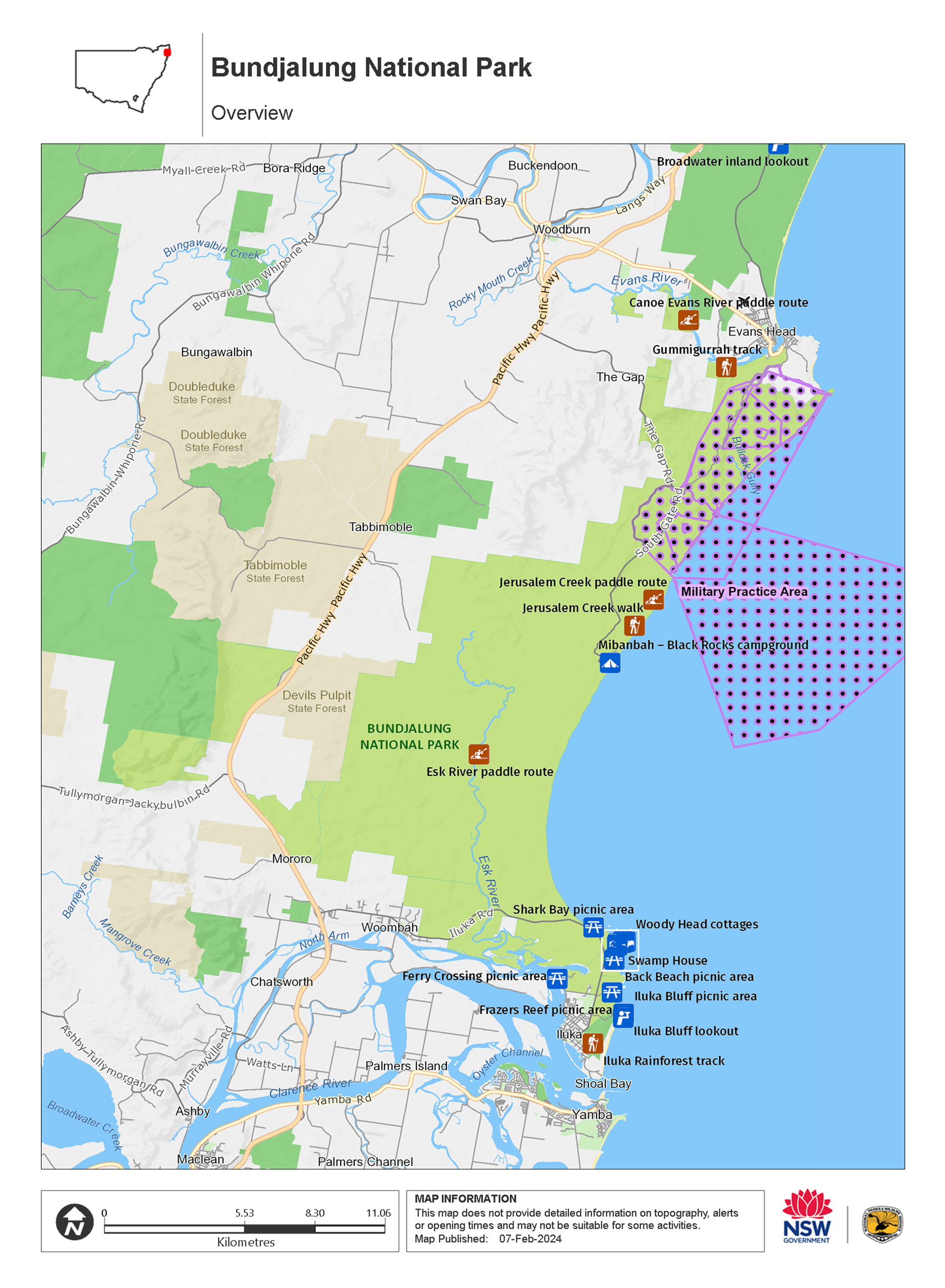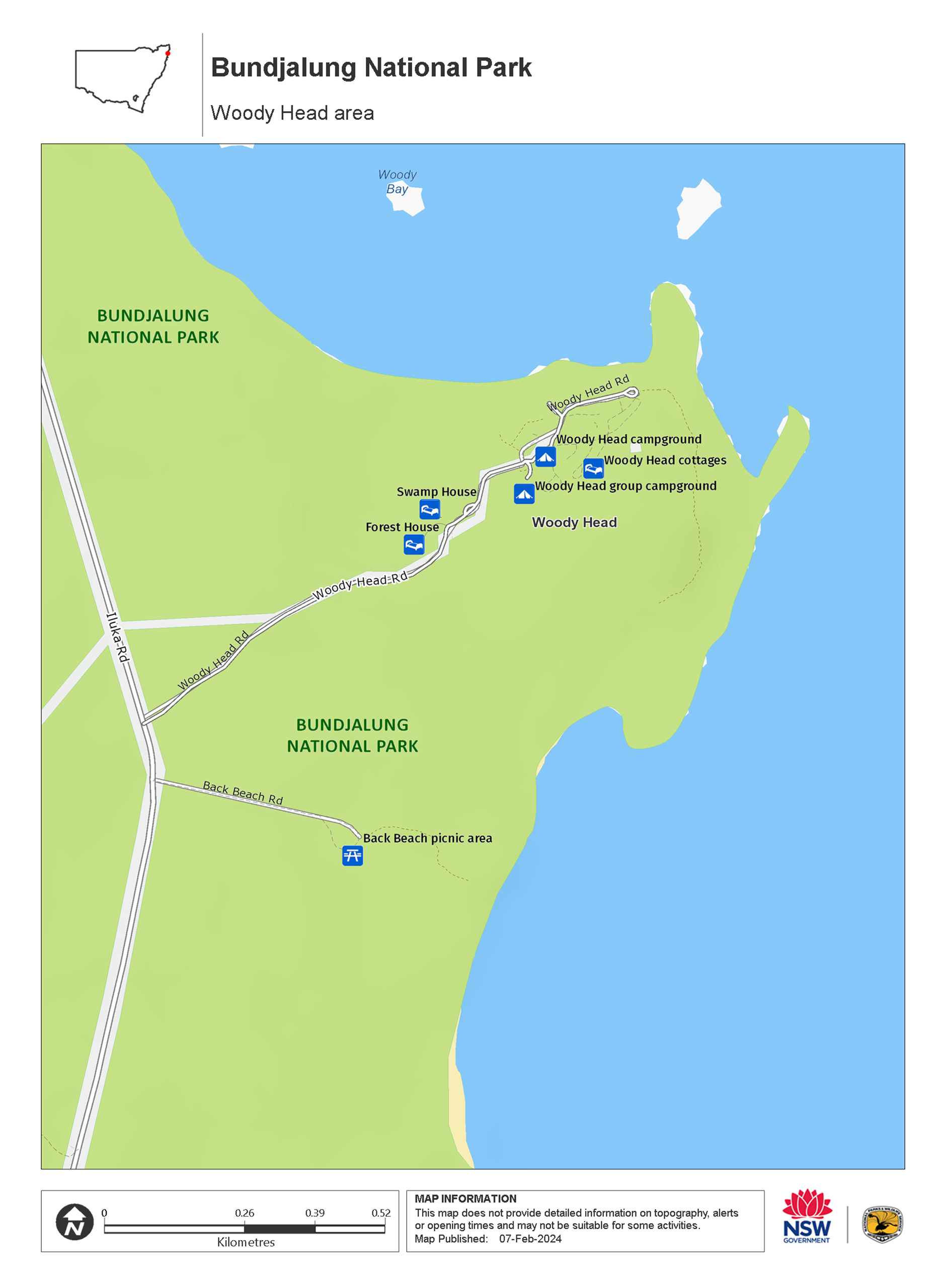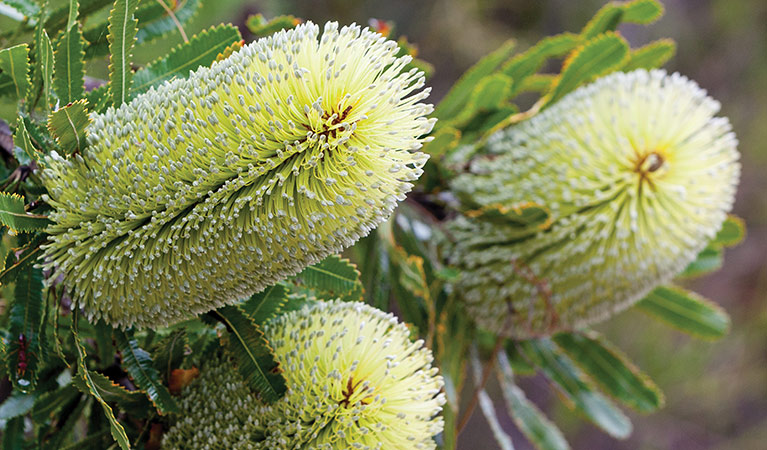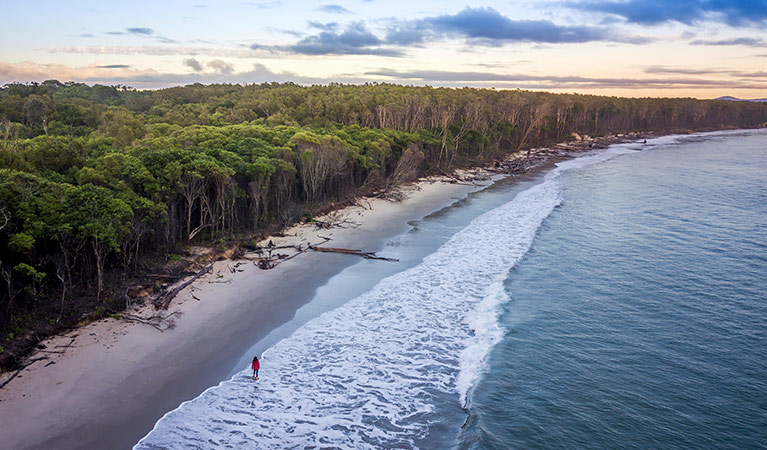Bundjalung National Park
Overview
Bundjalung National Park on the north coast, offers opportunities for beach walking, fishing, mountain biking and several school excursion options. Stay overnight in beach accommodation or camp out.
Read more about Bundjalung National Park
If you enjoy holidaying on the water, you’ll love Bundjalung’s combination of river, beach and freshwater lagoons. This north coast park stretches north from Iluka to Evans Head with the Pacific Ocean as its eastern boundary.
Spend a day canoeing along Evans River or Jerusalem Creek, mountain biking the Macaulays Lead or Serendipity fire trail, or walking along Ten Mile Beach. There are also boat launching facilities, snorkelling on the shallow reefs and fishing.
If you’d like to spend longer exploring, head to one of the beachside campgrounds in the park, or book into one of the Woody Head cabins. In the evening enjoy a barbecue dinner before gathering around the campfire with a local Bundjalung guide to listen to stories of their culture, values and connections to this park.
Local alerts
For the latest updates on fires, closures and other alerts in this area, see https://uat.nswparks.cloud/visit-a-park/parks/bundjalung-national-park/local-alerts
Map

Map

Map legend

Contact
- in the North Coast region
Bundjalung National Park is always open but may have to close at times due to poor weather or fire danger.
-
Park entry fees:
$8 per vehicle per day.
Buy annual pass. -
-
Alstonville office
02 6627 0200
Contact hours: Monday to Friday, 8:30am to 4:30pm - Russelton Industrial Estate, 7 Northcott Crescent, Alstonville NSW 2477
-
Email: npws.richmondriver@environment.nsw.gov.au
-
Alstonville office
-
-
Grafton office
02 6641 1500
Contact hours: Monday to Friday, 8.30am to 4.30pm. - Level 4, 49 Victoria Street, Grafton NSW 2460
-
Email: npws.clarence@environment.nsw.gov.au
-
Grafton office
Visitor info
All the practical information you need to know about Bundjalung National Park.
Maps and downloads
Nearby towns
Evans Head (1 km)
Evans Head is a peaceful, coastal fishing village located on the banks of the Evans River.
Iluka (2 km)
Iluka is a peaceful and scenic town with superb fishing and beaches. A coastal village, it's set on the north side of the Clarence River mouth.
Yamba (28 km)
Yamba is a bustling holiday resort with a large fishing fleet. It's built around a headland at the mouth of the Clarence River.
Learn more
Bundjalung National Park is a special place. Here are just some of the reasons why:
Water world

Bundjalung protects a variety of environments that feature water, including beaches, rivers, wetlands and lagoons. You'll find different types of plants, animals and birds in each one; look for coast banksia, coast she-oak and coastal wattle on the dunes that back onto the beach. Immerse yourself in this world by canoeing the waterways, rambling in the rock pools and swimming in the ocean.
Meet the locals

The varied habitat of Bundjalung National Park is home to over 140 species of fauna. Wake to the morning melodies of eastern whip-birds, bower birds and the rare barred cuckoo-shrike. At dawn and dusk, you might find eastern grey kangaroos, red-necked wallabies and swamp wallabies congregating around your campsites. Scour the tops of nearby trees and you might also catch a glimpse of a sleeping koala or two.
- Iluka Bluff lookout Stay as long as you like to enjoy the views at Iluka Bluff lookout, near Yamba. Not only is it an excellent whale watching spot, it’s also a great place to picnic.
- Jerusalem Creek walk Keep your eyes peeled for birds nesting along the creek along the Jerusalem Creek walk. Enjoy the hike as a day walk or shorter walk and finish up with a picnic lunch.
An ancient landscape

At Bundjalung National Park you can visit Gummigurrah, an area that was used as a winter camping ground by the Bandjalung People. This park is one of a group where the Bandjalang People's native title rights have been recognised and is only the third determination of native title rights in New South Wales. Native title rights come from the Bandjalang People's traditional laws and customs and legally recognise the Bandjalang People's connection to Country. This means that these lands will continue to be places of ceremony, learning and inspiration for generations to come.
Plants and animals protected in this park
Animals
-

White-bellied sea eagle (Haliaeetus leucogaster)
White-bellied sea eagles can be easily identified by their white tail and dark grey wings. These raptors are often spotted cruising the coastal breezes throughout Australia, and make for some scenic bird watching. Powerful Australian birds of prey, they are known to mate for life, and return each year to the same nest to breed.
-

Eastern ground parrot (Pezoporus wallicus wallicus)
The eastern ground parrot is a beautiful, ground-dwelling native bird that lives in low heathland habitat along the NSW North and South coasts and escarpments. It’s listed as a vulnerable species in NSW.
-

Peron's tree frog (Litoria peroni)
Peron’s tree frog is found right across NSW. These tree-climbing and ground-dwelling Australian animals can quickly change colour, ranging from pale green-grey by day, to a reddish brown with emerald green flecks at night. The male frog has a drill-like call, which has been described as a 'maniacal cackle’.
-

Emu (Dromaius novaehollandiae)
The largest of Australian birds, the emu stands up to 2m high and is the second largest bird in the world, after the ostrich. Emus live in pairs or family groups. The male emu incubates and rears the young, which will stay with the adult emus for up to 2 years.
-

Koala (Phascolarctos cinereus)
One of the most renowned Australian animals, the tree-dwelling marsupial koala can be found in gum tree forests and woodlands across eastern NSW, Victoria and Queensland, as well as in isolated regions in South Australia. With a vice-like grip, this perhaps most iconic but endangered Australian animal lives in tall eucalypts within a home range of several hectares.
-

Lace monitor (Varanus varius)
One of Australia’s largest lizards, the carnivorous tree-dwelling lace monitor, or tree goanna, can grow to 2m in length and is found in forests and coastal tablelands across eastern Australia. These Australian animals are typically dark blue in colour with whitish spots or blotches.
-

Grey-headed flying-fox (Pteropus poliocephalus)
The grey-headed flying fox is Australia's largest native bat, with a wingspan up to 1m. This threatened species travels up and down south-eastern Australia and plays a vital role in pollinating plants and spreading seeds in our native forests.
-

Australian pelican (Pelecanus conspicillatus)
The curious pelican is Australia’s largest flying bird and has the longest bill of any bird in the world. These Australian birds are found throughout Australian waterways and the pelican uses its throat pouch to trawl for fish. Pelicans breed all year round, congregating in large colonies on secluded beaches and islands.
Environments in this park
Education resources (1)
What we're doing
Bundjalung National Park has management strategies in place to protect and conserve the values of this park. View the detailed park and fire management documents. Here is just some of the work we’re doing to conserve these values:
Understanding landscapes and geology
Bundjalung National Park is dedicated to the maintenance of its landscapes and ensures this in conjunction with land and native vegetation conservation and ongoing attention to visitor safety and risk management.
Preserving biodiversity
NPWS is determined to protect and preserve significant ecosystems, habitats and endangered and vulnerable species throughout Bundjalung National Park. It strives to raise public awareness and understanding of these issues through interpretation programs, and works with park neighbours to conserve important wildlife habitats. Native tree planting, particularly those required by koalas, is ongoing in this park.
Managing weeds, pest animals and other threats
Pests and weeds have a significant impact to the ecosystems within Bundjalung National Park. Risk assessments for new and emerging weeds are carried out as an ongoing initiative within the park. Pest management of weeds such as bitou bush and other weeds, and wildlife like foxes, wild dogs and cane toads is a priority and an important part of the work NPWS does to protect the integrity of biodiversity which exists within Bundjalung.
Developing visitor facilities and experiences
The facilities and infrastructure in Bundjalung National Park are continually maintained and upgraded to ensure an optimal visitor experience. NPWS regularly reviews recreational opportunities in this park, identifying areas for improvement.
Conserving our Aboriginal culture
NPWS shares the management of Bundjalung National Park with members of the local Bandjalang Aboriginal community, and the two work together to help promote culture and reconciliation on national parks.
Managing fire
NSW is one of the most bushfire prone areas in the world as a result of our climate, weather systems, vegetation and the rugged terrain. NPWS is committed to maintaining natural and cultural heritage values and minimising the likelihood and impact of bushfires via a strategic program of fire research, fire planning, hazard reduction, highly trained rapid response firefighting crews and community alerts.

